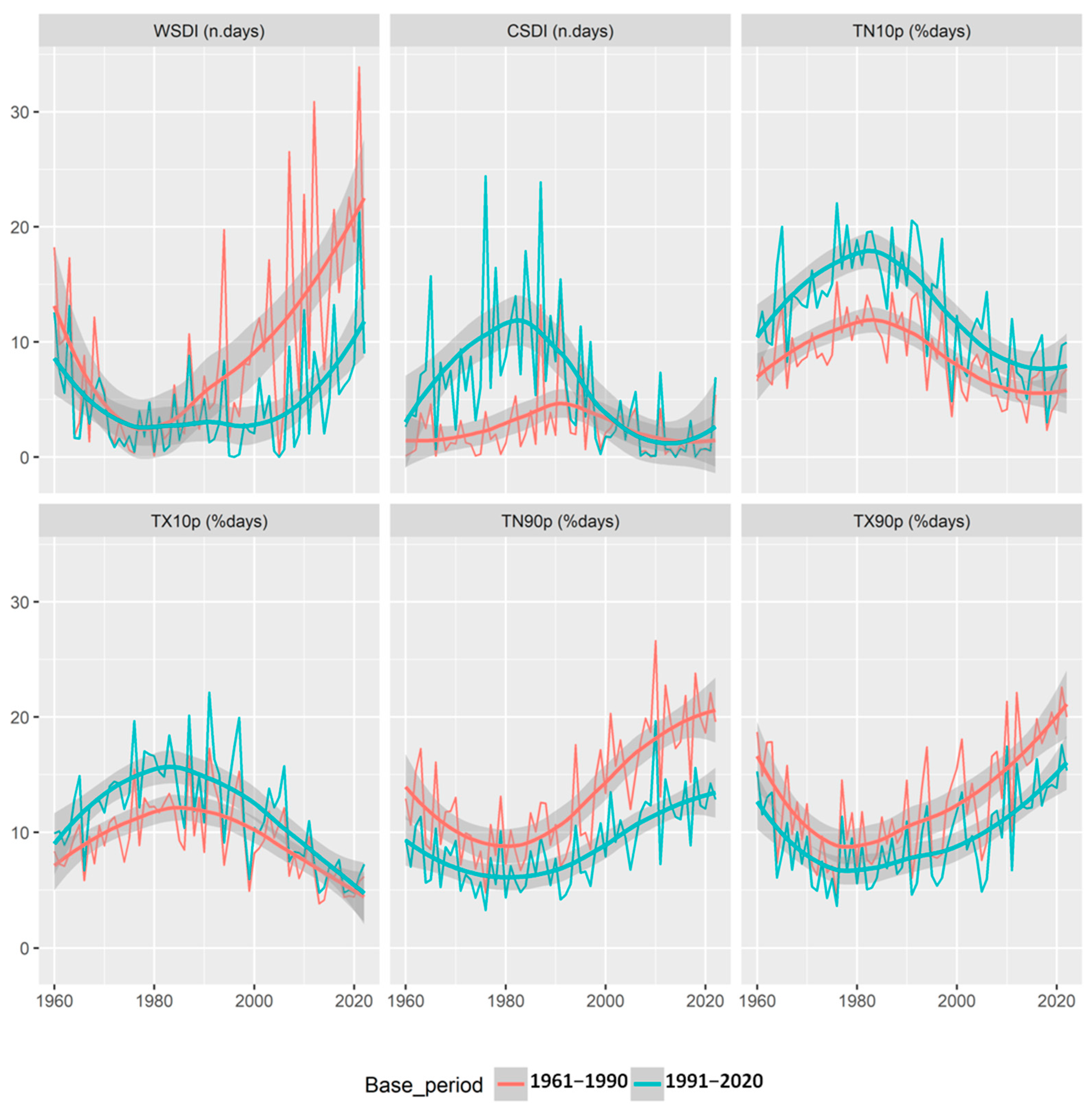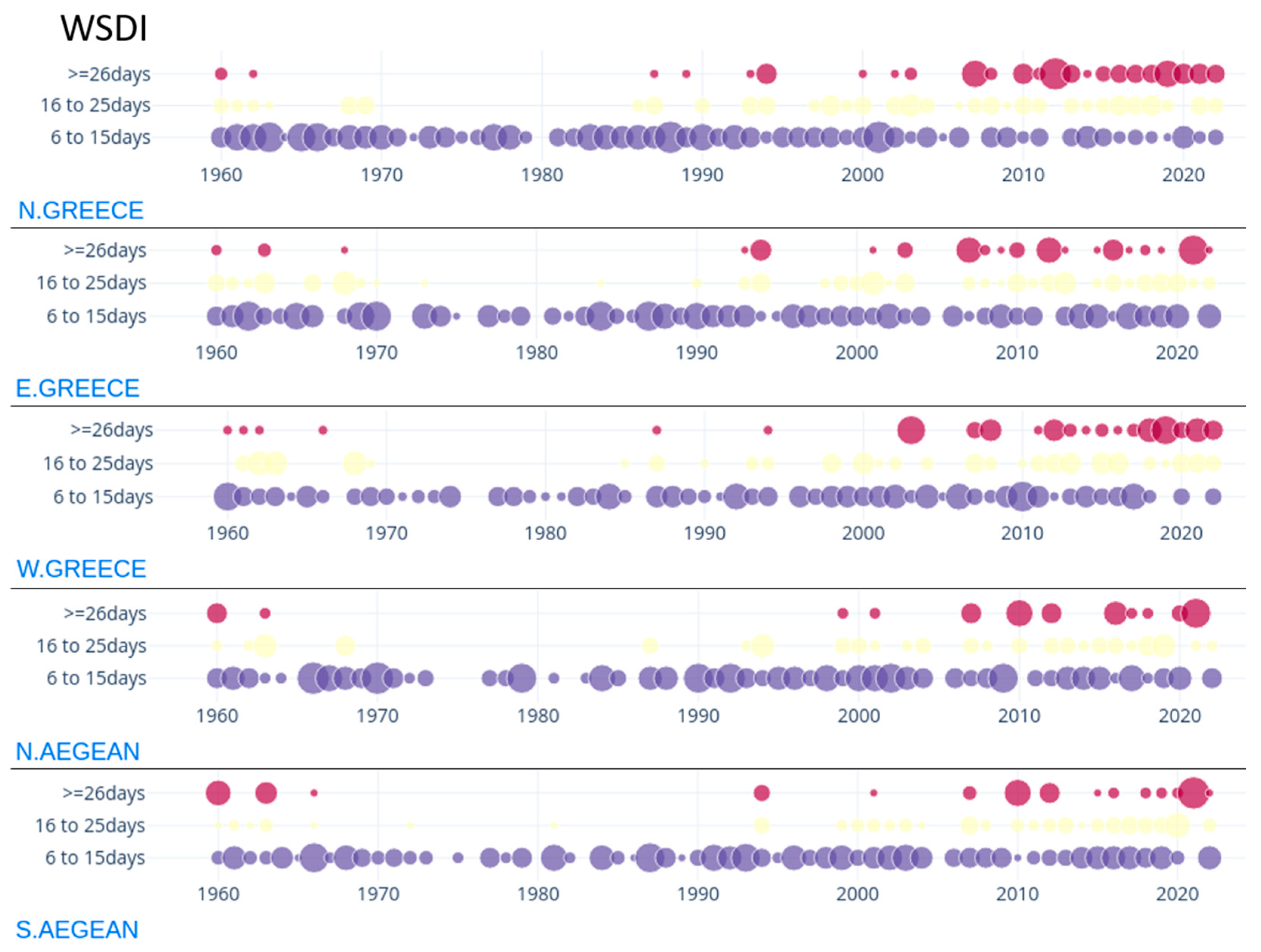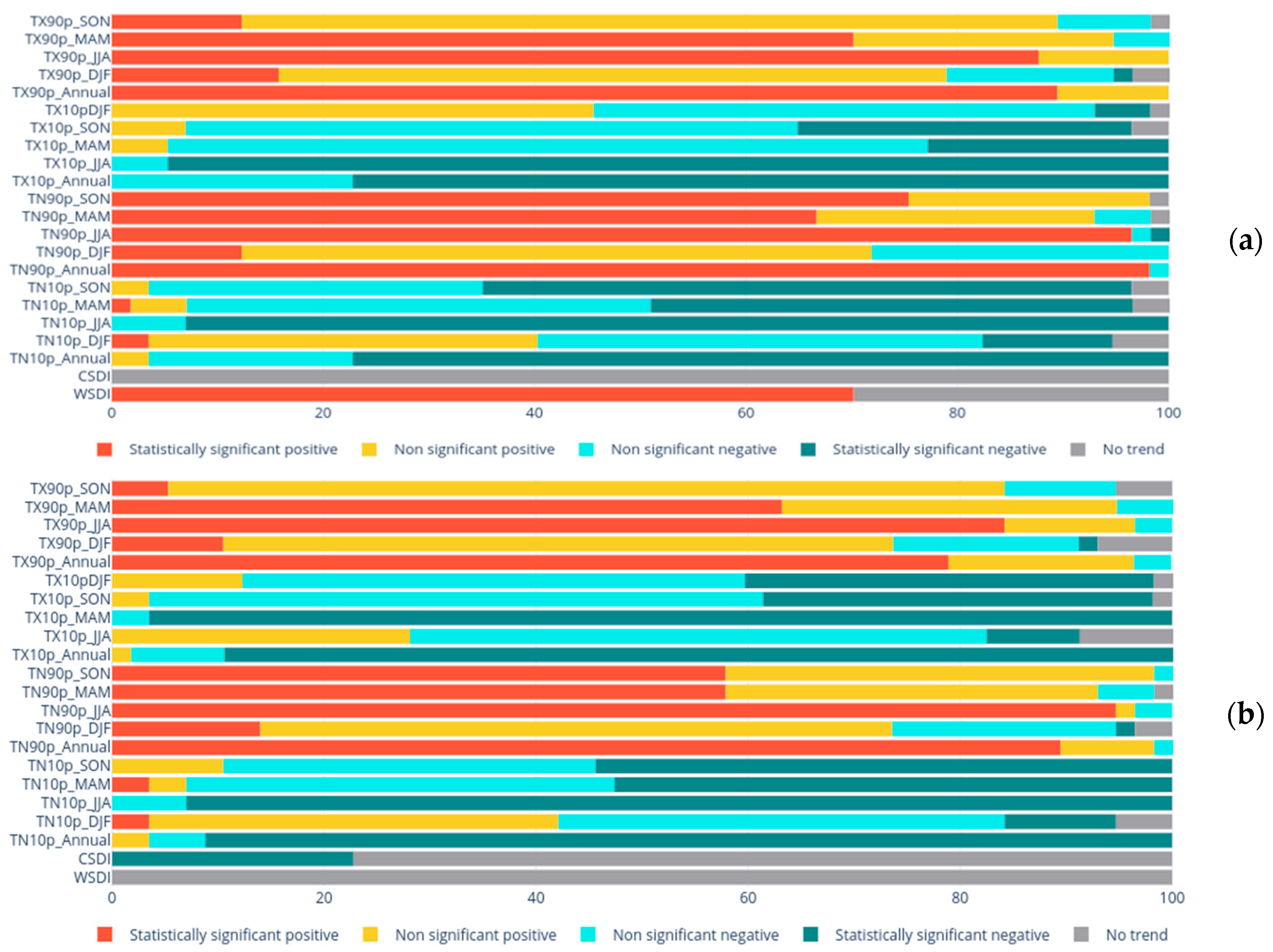Observed Changes in Temperature Extremes over Greece: Warm and Cold Spells †
Abstract
1. Introduction
2. Materials and Methods
2.1. Study Area, Data Source and Homogeneity
2.2. Extreme Temperature Indices and Trend Detection
3. Results
3.1. Behavior of Extreme Temperature Indices
3.2. Trend Analysis of Extreme Temperature Indices
4. Conclusions
Author Contributions
Funding
Institutional Review Board Statement
Informed Consent Statement
Data Availability Statement
Conflicts of Interest
References
- Tank, A.M.G.K.; Zwiers, F.W.; Zhang, X. Guidelines on Analysis of Extremes in a Changing Climate in Support of Informed Decisions for Adaptation; Climate Data and Monitoring WCDMP-No. 72; World Meteorological Organization: Geneva, Switzerland, 2009. [Google Scholar]
- WMO. Guidelines on Homogenization; WMO-No 1245; WMO: Geneva, Switzerland, 2020; p. 54. [Google Scholar]
- Guijarro, J.A. User’s Guide of the Climatol R Package (Version 4.1.0). 2023. Available online: https://cran.r-project.org/web/packages/climatol (accessed on 20 January 2023).
- Mamara, A.; Argiriou, A.A.; Anadranistakis, M. Homogenization of mean monthly temperature time series of Greece. Ιnt. J. Climatol. 2013, 33, 2649–2666. [Google Scholar] [CrossRef]
- Zhang, X.; Alexander, L.; Hegerl, G.C.; Jones, P.; Tank, A.K.; Peterson, T.C.; Trewin, B.; Zwiers, F.W. Indices for monitoring changes in extremes based on daily temperature and precipitation data. Wiley Interdiscip. Rev. Clim. 2011, 2, 851–870. [Google Scholar] [CrossRef]
- WMO. Guidelines on the Calculation of Climate Normals; WMO-No. 1203; WMO: Geneva, Switzerland, 2017. [Google Scholar]
- Yosef, Y.; Aguilar, E.; Alpert, P. Changes in Extreme Temperature and Precipitation Indices: Using an Innovative Daily Homogenized Database in Israel. Int. J. Climatol. 2019, 39, 5022–5045. [Google Scholar] [CrossRef]
- Stocker, T.F.; Qin, D.; Plattner, G.K.; Tignor, M.; Allen, S.K.; Boschung, J.; Nauels, A.; Xia, Y.; Bex, V.; Midgley, P.M. Climate Change 2013: The Physical Science Basis: Working Group I Contribution to the Fifth Assessment Report of the Intergovernmental Panel on Climate Change; Cambridge University Press: Cambridge, UK, 2014. [Google Scholar]



| Name (Lat Lon) | Name (Lat Lon) | Name (Lat Lon) |
|---|---|---|
| Aghialos (22.793 39.224) | Kalamata (22.023 37.069) | N.Filadelfeia (23.746 38.045) |
| Aktio (20.769 38.922) | Karpathos (27.147 35.428) | Naxos (25.373 37.101) |
| Alexandroupoli (25.947 40.857) | Karystos (24.391 38.001) | Paros (25.115 37.022) |
| Andravida (21.287 37.923) | Kasteli (25.329 35.189) | Rhodes (28.089 36.402) |
| Araxos (21.422 38.149) | Kastoria (21.274 40.448) | Samos (26.916 37.691) |
| Argos (22.760 37.633) | Kerkyra (19.914 39.608) | Santorini (25.474 36.402) |
| Argostoli (20.505 38.120) | Kithira (22.989 36.149) | Serres (23.529 41.077) |
| Astros (22.719 37.406) | Konitsa (20.738 40.046) | Sitia (26.103 35.216) |
| Chios (26.142 38.345) | Kos (27.091 36.801) | Skiathos (23.502 39.175) |
| Chrysoupoli (24.620 40.920) | Kozani (21.842 40.289) | Skyros (24.491 38.963) |
| Desfina (22.5298 38.4208) | Lamia (22.436 38.877) | Souda (24.145 35.529) |
| Doxato (24.252 41.066) | Larisa (22.460 39.646) | Soufli (26.291 41.194) |
| Edessa (22.041 40.809) | Leonidio (22.892 37.151) | Spata (23.931 37.921) |
| Elefsis (23.552 38.068) | Limnos (25.233 39.922) | Syros (24.949 37.427) |
| Florina (21.428 40.805) | Macedonia (22.970 40.529) | Tanagra (23.563 38.335) |
| Helliniko (23.742 37.890) | Methoni (21.705 36.825) | Tatoi (23.780 38.107) |
| Heraklio (25.182 35.335) | Milos (24.429 36.739) | Tripoli (22.397 37.525) |
| Ikaria (26.345 37.683) | Mykonos (25.346 37.436) | Xanthi (24.903 41.137) |
| Ioannina (20.819 39.695) | Mytilini (26.604 39.054) | Zakynthos (20.888 37.751) |
| Name | Units | Definition |
|---|---|---|
| Warm Spell (WSDI) | day | Annual count of days with at least 6 consecutive days when daily max temperature > 90th percentile centered on a 5-day window |
| Cold Spell (CSDI) | day | Annual count of days with at least 6 consecutive days when daily min temperature < 10th percentile centered on a 5-day window |
| Warm Days (TX90p) | % | Percentage of days with max temperature above the corresponding calendar day 90th percentile for a 5-day moving window |
| Warm Nights (TN90p) | % | Percentage of days with min temperature above the corresponding calendar day 90th percentile for a 5-day moving window |
| Cold Days (TX10p) | % | Percentage of days with max temperature below the corresponding calendar day 10th percentile for a 5-day moving window |
| Cold Nights (TN10p) | % | Percentage of days with min temperature below the corresponding calendar day 10th percentile for a 5-day moving window |
| Index | 1961–1990 | 1991–2020 |
|---|---|---|
| WSDI | 2.08 | 0.24 |
| CSDI | −0.01 | −1.24 |
| TN10p | −0.78 | −1.41 |
| TX10p | −0.63 | −1.18 |
| TN90p | 1.84 | 1.07 |
| TX90p | 1.43 | 0.94 |
Disclaimer/Publisher’s Note: The statements, opinions and data contained in all publications are solely those of the individual author(s) and contributor(s) and not of MDPI and/or the editor(s). MDPI and/or the editor(s) disclaim responsibility for any injury to people or property resulting from any ideas, methods, instructions or products referred to in the content. |
© 2025 by the authors. Licensee MDPI, Basel, Switzerland. This article is an open access article distributed under the terms and conditions of the Creative Commons Attribution (CC BY) license (https://creativecommons.org/licenses/by/4.0/).
Share and Cite
Mamara, A.; Argiriou, A.A.; Karatarakis, N.; Armaos, V. Observed Changes in Temperature Extremes over Greece: Warm and Cold Spells. Environ. Earth Sci. Proc. 2025, 35, 68. https://doi.org/10.3390/eesp2025035068
Mamara A, Argiriou AA, Karatarakis N, Armaos V. Observed Changes in Temperature Extremes over Greece: Warm and Cold Spells. Environmental and Earth Sciences Proceedings. 2025; 35(1):68. https://doi.org/10.3390/eesp2025035068
Chicago/Turabian StyleMamara, Anna, Athanasios A. Argiriou, Nikolaos Karatarakis, and Vasileios Armaos. 2025. "Observed Changes in Temperature Extremes over Greece: Warm and Cold Spells" Environmental and Earth Sciences Proceedings 35, no. 1: 68. https://doi.org/10.3390/eesp2025035068
APA StyleMamara, A., Argiriou, A. A., Karatarakis, N., & Armaos, V. (2025). Observed Changes in Temperature Extremes over Greece: Warm and Cold Spells. Environmental and Earth Sciences Proceedings, 35(1), 68. https://doi.org/10.3390/eesp2025035068







